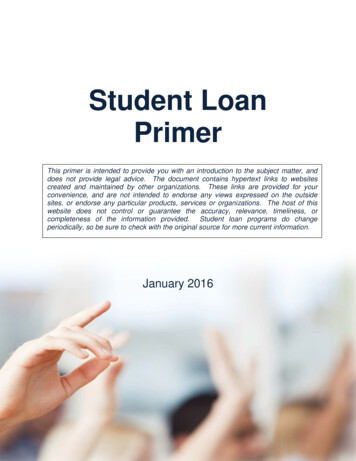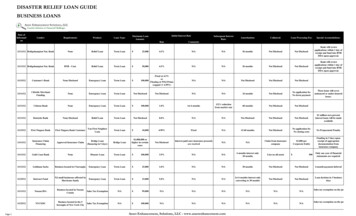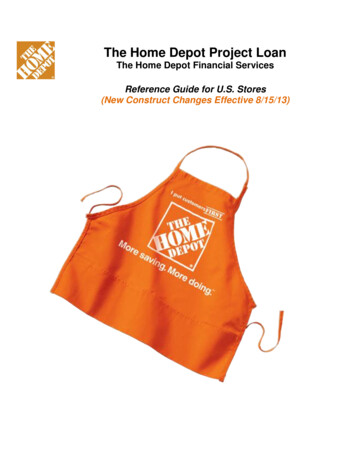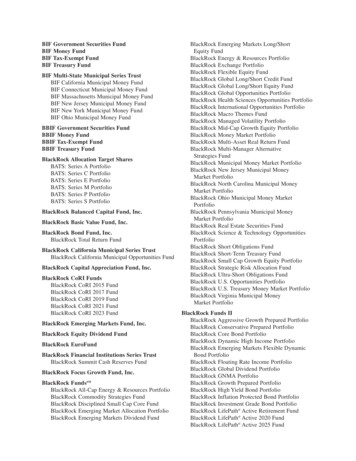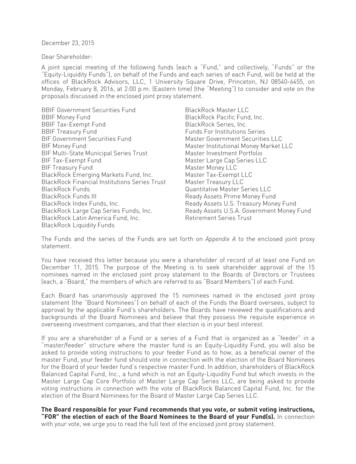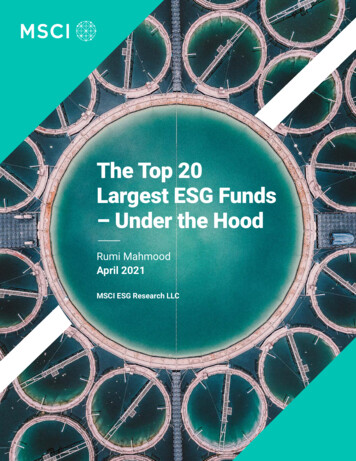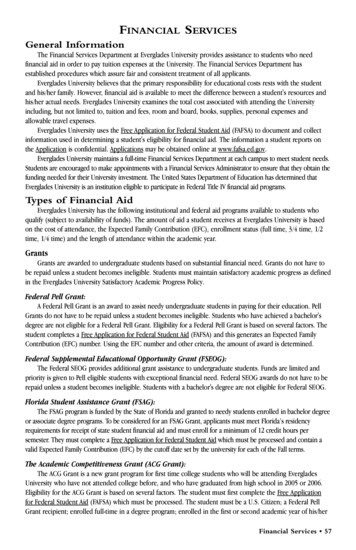
Transcription
Green Jobs - Green New YorkResidential Financing Implementation ManualFor Participating ContractorsJanuary 2021
This manual is intended to provide Participating Contractors with information on the Green Jobs - GreenNew York (GJGNY) Loan Fund and the process for offering a GJGNY loan to customers. This manual doesnot cover the NYSun or Renewable Heat NY programs.DefinitionsComfort Home Assessment: For the Comfort Home Program, the audit is completed by a participatingComfort Home contractor who assesses the opportunity for implementation of standard measurepackages (air sealing, attic and wall insulation, ENERGY STAR windows) to make the home more energyefficient. The estimated savings for these improvements are calculated using Energy Plus modelingsoftware and the reduction in the heating and cooling load on the home’s heating and cooling systemsand the annual fuel and electric savings are reported.Heat Pump Financing Certificate of Completion: The GJGNY Loan Fund Heat Pump Financing Certificateof Completion is executed by a Customer attesting that all work has been completed pursuant to thecontract.Heat Pump Energy Audit: For purposes of the Statewide Heat Pump Program, this is accomplished by thecompletion of an Air Conditioning Contractors of America (ACCA) Manual J: Residential Load Calculation.This heat load calculation represents a building’s heating, cooling, and dehumidification capacity neededfor a heating and/or cooling unit under design conditions.Participation Agreement: The GJGNY Loan Fund Residential Financing Contractor ParticipationAgreement establishes the terms and conditions under which Participating Contractors may offer aGJGNY loan to qualified customers in New York State.Participating Contractor: Participating contractors are independent contractors approved to offer GJGNYfinancing and participate in the New York Residential Existing Homes Program, NYSERDA Comfort HomeProgram, or is a participating contractor with PSEG-Long Island Home Comfort Program or the StatewideUtility Heat Pump ProgramParticipating Auditor: Participating auditors are companies or organizations that meet the participationcriteria as detailed in the Residential Energy Audit Program Participation Agreement, the ProgramManual and any Program announcements and have been approved by NYSERDA to offer ResidentialEnergy Audits.Proforma: Proforma is a tool that determines if the selected measures meet GJGNY and Companion loancost effectiveness requirements and notifies NYSERDA’s loan originator if a customer wants aCompanion LoanResidential Financing Certificate of Completion: The GJGNY Loan Fund Residential Financing Certificateof Completion is executed by a Customer attesting that all work has been completed pursuant to thecontract.1
Residential Energy Audit: An energy audit conducted by a Participating Auditor in accordance with thepolicies and procedures detailed in this Residential Energy Audit Participation Agreement, theResidential Energy Audit Program Manual, and any Residential Energy Audit Program announcements.2
1 Overview of Loan Products1.1Background of Green - Jobs Green NY FinancingThe New York State Energy Research and Development Authority (NYSERDA) administers the Green Jobs- Green New York (GJGNY) Loan Fund for Residential Financing (the GJGNY Loan Fund), which wasauthorized by Title 9-A of Article 8 of the Public Authorities Law of the State of New York, as amended(known as the Green Jobs - Green New York Act) to finance energy audits and energy efficiency retrofitsor improvements, including solar energy and other renewable installations, for the owners of residentialone- to four-family buildings (GJGNY loan).To pursue financing through the GJGNY Loan Fund, a customer must have either a Heat Pump EnergyAudit, a Comfort Home Assessment, or a Residential Energy Audit or an energy assessment thatidentifies energy services to be undertaken. The Heat Pump Energy Audit must be performed inaccordance with ACCA Manual J. The Comfort Home Assessment must be performed through theComfort Home Program. The Residential Energy Audit must be performed through the ResidentialEnergy Audit Program or the energy assessment must be performed under the Residential ExistingHomes Program.The total cost of the project may include the removal of equipment or systems, the purchase andinstallation of new systems or equipment, and any required ancillary equipment and related services,including necessary health and safety improvements.NYSERDA also administers Companion Loans which are funded by the New York Green Bank, a divisionof NYSERDA. The Companion Loan will be available to customers that fully utilized the GJGNY Loan fortheir energy efficiency or renewable energy project and need additional loan funding to pay forremaining project costs.GJGNY offers three types of unsecured loans for one- to four-family residential energy improvements.The Smart Energy Loan requires the consumer to make monthly loan payments directly to NYSERDA’sloan servicer, Concord Servicing Corporation (Concord). The On-Bill Recovery (OBR) Loan allowsconsumers to repay through an installment charge on a bill from one of the involved electric or gasutilities (Central Hudson, Con Edison, Long Island Power Authority, National Grid - Upstate, New YorkState Electric and Gas Corporation, Rochester Gas and Electric Corporation, or Orange and RocklandUtilities). The utilities then remit repayments to Concord, who coordinates data communications witheach utility. The Renewable Energy Tax Credit Bridge Loan is a short-term loan product which enablescustomers to finance federal and state tax credits and New York City (NYC) Real Property Tax Abatementfor eligible renewable energy system costs. Customers will make a balloon payment of principal andinterest at loan maturity via statement billing/check or automatic (ACH) payment.Companion Loans will be an unsecured loan modeled after the Smart Energy Loan (repaid by statementbilling/check or ACH payment). The Companion Loan is not eligible for On-Bill Recovery (paid throughutility). Separate loan documents and notes will be issued for the GJGNY Loan and the Companion Loan.NYSERDA’s loan originator, Slipstream, will originate both loans simultaneously.3
1.21.2.1Loan InformationLoan AmountGJGNY Loan amounts range from 1,500 to 25,000. For loans more than 13,000, the simple paybackmust be less than 15 years, calculated as:(Net Consumer Cost Investment**)/(Future Value* of the Annual Savings/Loan Term)*Future value is calculated by using the annual Fuel Escalation Rate of 1.2%** Net Consumer Cost Investment equals total project costs less incentives less tax credits lessreplacement costsHomeowners can have multiple GJGNY Loans provided that the aggregate outstanding loan amountdoesn’t exceed 25,000. However, homeowners may only have one outstanding OBR Loan at any giventime.Companion Loan amounts range from 1,500 to 25,000 and can only be accessed when the customerhas fully utilized the 25,000 GJGNY Loan. Companion Loans are not subject to simple paybackcalculation.1.2.2Loan TermLoans terms are 2 (GJGNY Bridge Loan only), 5, 10, or 15 years. The loan term may not exceed theexpected useful life of the home energy improvements. GJGNY and Companion Loans do not have tohave the same loan term.1.2.3Loan Origination FeesThe customer will be charged a 150 loan origination fee. The fee can be included in the GJGNY Loanamount(s), provided the total of the GJGNY loan amounts do not exceed 25,000.1.3 Smart Energy LoanThe Smart Energy Loan is a traditional unsecured loan that is repaid monthly via check or automaticpayment. The applicant (or co-applicant) must own the home, or lease or manage the residentialbuilding and be an authorized representative of the owner.1.3.1Interest RatesCurrent interest rates are 3.99% or 7.49%. A 0.5% interest rate discount is applied to these rates if thecustomer selects automatic payments prior to loan closing. Interest rates are subject to change.4
Using the Housing and Urban Development (HUD) Income Block Data, NYSERDA identified Census BlockGroups where census data reports that 50% or more of the population of the Census Block Group have ahousehold income less than or equal to 120% (Designated Areas).NYSERDA developed a web-based Geo-Eligibility tool that allows an applicant or contractor to enter theaddress and immediately be advised if the applicant is eligible for the lower interest rate. If not, theapplicant is re-directed to an interest rate estimator to determine which interest rate may be availablebased on the area median income (AMI) and number of household members. The Geo-Eligibility tool forapplicants can be found on NYSERDA's website at nyserda.ny.gov/lower- rates. A separate tool isavailable to contractors that provides a map of the State and the Designated Areas and can be found onNYSERDA's website at nyserda.ny.gov/eligible-residents.If an applicant's address is located within a Designated Area, he/she will be deemed eligible for the3.49%/3.99% interest rate and will not have to provide documentation of household income. Theapplicant/co-applicant will still have to provide income documentation for debt-to-income calculation, ifapplicable, in accordance with NYSERDA's underwriting guidelines.If the applicant's address is outside of a Designated Area, he/she will have to opportunity to apply forthe lower rate by documenting household income is less than or equal to 120% of the AMI.1.3.2Repayment TermsPayments are made directly to NYSERDA’s loan servicer, Concord, via monthly statement billing orautomatic bank withdrawal (ACH).If the home is sold or transferred, the borrower is responsible for the outstanding balance of the loanand the loan cannot be assigned to the new owner.Non-payment of the loan obligation may result in a lawsuit against the borrower, wherein the State ofNew York will seek the entry of a judgement with interest, costs and collection fees as provided by theState Finance Law.1.3.3Loan Servicing Fees Late payment fee is the lesser of 5% or 5 20 fee for returned payments Collection fee of 22% of the total amount due (principal, accrued interest and late fees) if notreceived within 275 days of due date, as authorized by State Finance Law1.3.4Cost Effectiveness RequirementsThe project is considered cost effective if at least 85% of the total loan amount is comprised of prequalified eligible measures or the estimated energy cost savings over the anticipated life of all eligibleenergy efficiency or renewable improvements amounts to at least 80% of the total GJGNY Loan andCompanion Loan (if applicable) principal and interest (see section 1.6.2).5
1.3.5DocumentationFollowing loan approval, Slipstream will send the applicant(s) a Loan Agreement, Disclosure and SecurityAgreement (Note), Smart Energy Notice to Borrower, and a Notice of Right to Cancel, all of which mustbe signed and returned to Slipstream. When the loan proceeds are disbursed, the loan is transferred toConcord for servicing.1.4 On-Bill Recovery LoanWith the OBR Loan, loan payments are built into the customer’s energy utility bill. The applicant (or coapplicant) must own the home, be named on the utility account of a participating utility: CentralHudson, Con Edison, PSEG-Long Island, National Grid (upstate customers only), New York State Electricand Gas Corporation, Orange and Rockland Utilities, or Rochester Gas and Electric and not be on anytype of deferred payment plan with the utility. A declaration must be filed with the county clerk in thecounty in which the installation property is located. A title company under contract with NYSERDA willsearch public records to verify ownership of the property.1.4.1Interest RatesCurrent interest rates are 6.99% or 3.49%. Interest rates are subject to change.Using the Housing and Urban Development (HUD) Income Block Data, NYSERDA has identified CensusBlock Groups where census data reports that 50% or more of the population of the Census Block Grouphave a household income less than or equal to 120% (Designated Areas).NYSERDA developed a web-based Geo-Eligibility tool that allows an applicant or contractor to enter theaddress and immediately be advised if the applicant is eligible for the lower interest rate. If not, theapplicant is redirected to an interest rate estimator to determine which interest rate may be availablebased on the area median income (AMI) and number of household members. The Geo-Eligibility tool forapplicants can be found on NYSERDA's website at nyserda.ny.gov/lower- rates. A separate tool isavailable to contractors that provides a map of the State and the Designated Areas and can be found onNYSERDA's website at nyserda.ny.gov/eligible-residents.If an applicant's address is located within a Designated Area, he/she will be deemed eligible for the3.49%/3.99% interest rate and will not have to provide documentation of household income. Theapplicant/co-applicant will still have to provide income documentation for debt-to-income calculation, ifapplicable, in accordance with NYSERDA's underwriting guidelines.If the applicant's address is outside of a Designated Area, he/she will have to opportunity to apply forthe lower rate by documenting household income is less than or equal to 120% of the AMI.1.4.2Repayment TermsPayments are added to the borrower’s utility bill as a NYSERDA Loan Installment charge. If utility serviceis terminated or suspended, the borrower will be billed directly by Concord.6
1.4.3DocumentationFollowing loan approval, Slipstream will send the applicant(s) a loan agreement (Note), Notice of Rightto Cancel, and a Declaration. The documents must be signed, and the Declaration must be notarized andreturned to Slipstream. When the loan proceeds are disbursed, the loan is transferred to Concord.1.4.4Loan TransferThe OBR loan is transferrable upon the sale of the home and requires that the seller provide writtennotice to prospective buyers in accordance with the terms of the Note. If the loan is not transferred tothe new homeowner, then it must be paid-off at the time of property transfer. If the loan is transferredto the new homeowner, the utility, and Concord will work together to have the monthly loanassessment placed on the utility bill. The seller is responsible for amounts billed by the utility up to thedate of transfer.1.4.5Non-PaymentNon-payment of utility charges or the OBR loan obligation may result in termination of utility service;non-payment of the loan obligation may result in collection efforts including the entry of a judgmentwith interest, costs and collection fees as provided by the State Finance Law.1.4.6Fees If Concord directly bills the borrower(s) the following may apply: Late payment fee is the lesser of 5% or 5 20 fee for returned payments Returned payment fee may be charged by the utility as authorized by the Public ServiceCommission Past due balance on utility account may be subject to a collection fee by the utility as authorizedby the Public Service Commission If utility service is terminated, borrower may be subject to a reconnection fee from the utility1.4.7Cost Effectiveness RequirementsThe monthly payment may not exceed 1/12th of the estimated average annual energy cost savings fromthe improvements over the loan term. In other words, the monthly payments may not exceed theestimated average monthly energy cost savings.7
1.4.8DetailsOnly one OBR Loan per utility meter account is allowed at any one time. The utility account must be inthe name of the borrower.All individuals or legal entity representatives named on the property deed must sign and have notarizedan On-Bill Recovery Program Declaration, which will be filed by NYSERDA with the county clerk in thecounty in which the installation property is located. This provides notice to any subsequent purchaser ofthe property. The declaration is not a lien on the property but is recorded to provide notice to others ofthe loan obligation.1.5 Renewable Energy Tax Credit Bridge LoanThe Bridge Loan is a short-term unsecured loan available to GJGNY financing customers that want toborrow a portion of the renewable energy system cost that may be eligible for a federal or state incometax credit or NYC Real Property Tax Abatement. The applicant (or co-applicant) must own the home, orlease or manage the residential building and be an authorized representative of the owner.Bridge Loans are funded through the GJGNY Loan fund and can be paired with a traditional GJGNY TermLoan (combined loan amounts cannot exceed 25,000) and a Companion Loan.1.5.1Loan AmountThe Bridge Loan amount may not exceed the maximum of: Federal income tax credit of 22% for systems installed in calendar year 2021 the New York State income tax credit for solar projects equal to the lesser of 5,000 or 25% ofthe net project cost the NYC Real Property Tax Abatement of 5% of the net project cost (offered for a four-yearperiod, but only one year can be included in the Loan)1.5.2Interest RatesCurrent interest rates are 3.99% or 7.49%. A 0.5% interest rate discount is applied to these rates if thecustomer selects automatic payments prior to loan closing. Interest rates are subject to change.Using the Housing and Urban Development (HUD) Income Block Data, NYSERDA identified Census BlockGroups where census data reports that 50% or more of the population of the Census Block Group have ahousehold income less than or equal to 120% (Designated Areas).NYSERDA developed a web-based Geo-Eligibility tool that allows an applicant or contractor to enter theaddress and immediately be advised if the applicant is eligible for the lower interest rate. If not, theapplicant is re-directed to an interest rate estimator to determine which interest rate may be availablebased on the area median income (AMI) and number of household members. The Geo-Eligibility tool forapplicants can be found on NYSERDA's website at nyserda.ny.gov/lower- rates. A separate tool is8
available to contractors that provides a map of the State and the Designated Areas and can be found onNYSERDA's website at nyserda.ny.gov/eligible-residents.If an applicant's address is located within a Designated Area, he/she will be deemed eligible for the3.49%/3.99% interest rate and will not have to provide documentation of household income. Theapplicant/co-applicant will still have to provide income documentation for debt-to-income calculation, ifapplicable, in accordance with NYSERDA's underwriting guidelines.If the applicant's address is outside of a Designated Area, he/she will have to opportunity to apply forthe lower rate by documenting household income is less than or equal to 120% of the AMI.1.5.3Repayment TermsThe Bridge Loan will have a balloon payment of principal and interest due at maturity (two years fromloan origination). There will be no penalty for pre-payments.Payments are made directly to NYSERDA’s loan servicer, Concord, via statement billing or automaticbank withdrawal (ACH).If the home is sold or transferred, the borrower is responsible for the outstanding balance of the loanand the loan cannot be assigned to the new owner.Non-payment of the loan obligation may result in a lawsuit against the borrower, wherein the State ofNew York will seek the entry of a judgement with interest, costs and collection fees as provided by theState Finance Law.1.5.4Loan Servicing Fees Late payment fee is 25.00 per month 20 fee for returned payments Collection fee of 22% of the total amount due (principal, accrued interest and late fees) if notreceived within 275 days of due date, as authorized by State Finance Law1.5.5Customer Notice RequirementsContractors will be required to provide customers with the NYSERDA Residential Renewable Energy TaxCredit Bridge Loan notice when offering the customer the Bridge Loan. The notice is posted onNYSERDA’s website.1.5.6Cost Effectiveness RequirementsThe project is considere
With the OBR Loan, loan payments are built into the customer’s energy utility bill. The applicant (or co- applicant) must own the home, be named on the utility account of a participating utility: Central Hudson, Con Edison, PSEG-Long Island, Nation



